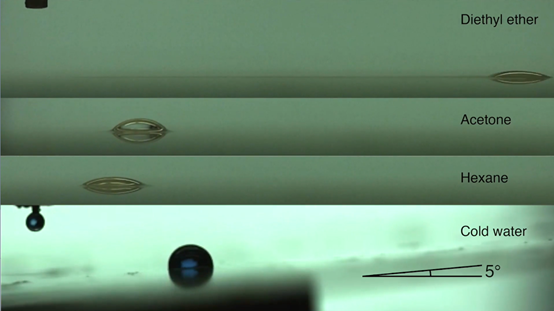A major discovery in droplet manipulation has been made by scientists from the Department of Mechanical Engineering at the University of Hong Kong (HKU). They have also found an innovative method to navigate liquids on a surface in the absence of external energy or force.
 When a cold/hot or volatile droplet is liberated on a lubricated piezoelectric crystal (lithium niobate) at ambient temperature, the droplet instantaneously propels for a long-distance Image Credit: The University of Hong Kong.
When a cold/hot or volatile droplet is liberated on a lubricated piezoelectric crystal (lithium niobate) at ambient temperature, the droplet instantaneously propels for a long-distance Image Credit: The University of Hong Kong.
The shape of the droplet seems to appear like a ball. In-plane droplet control is similar to the game of snooker, where the balls are guided to move along a preferred trajectory. It is a feature that has been greatly valued for desalination, thermal management, materials self-delivery and various other applications.
Scientists traditionally fabricate chemical wetting gradient or asymmetric microtextures to force droplets into motion, which is quite similar to designing a conveyor belt to transport the balls.
The RGC postdoctoral fellow Dr. Xin Tang, Postdoctoral fellow Dr. Li Wei, and Chair Professor of Thermal-Fluid Sciences and Engineering Liqiu Wang from the HKU Department of Mechanical Engineering, for the first time, have found out that when a cold/hot or volatile droplet is released on a lubricated piezoelectric crystal (lithium niobate) at ambient temperature, the droplet instantly propels for a long distance (which could be approximately 50 times the droplet radius) in furcated routes.
The self-propulsion could be bifurcated, unidirectional and even trifurcated based on the crystal plane that interfaces with the droplet. The breakthrough has been reported in the journal Nature Nanotechnology in an article titled “Furcated Droplet Motility on Crystalline Surfaces.”
This is an unforeseen phenomenon with far-reaching implications. Droplets with a temperature difference mild at 5 °C on a surface can undergo self-sustained propulsion. Imagine placing a ball on a perfectly leveled and smooth table, instead of remaining static, the ball rolls by itself. Even more surprising is that the ball only automatically rolls towards certain definite directions.
Wang Liqiu, Chair Professor of Thermal-Fluid Sciences and Engineering, Department of Mechanical Engineering, The University of Hong Kong
Scientists have discovered that the intrinsically orientated liquid motion has been fueled by the cross-scale thermo-piezoelectric coupling, which is created by the anisotropy of crystal structure. This resembles the atomic arrangement of the smooth table in a strange way such that a symmetric heat source can generate an asymmetric electric field that pushes a ball into motion in a direction established by the cutting direction of the table surface.
The work enables an innovative way to deliver and transport liquids with controllability, versatility and performance, and provides clues for solving some long-standing challenges such as anti-icing, defrost and antifog in humid environments.
Dr. Tang Xin, Department of Mechanical Engineering, The University of Hong Kong
As soon as a droplet hits a supercooled substrate, like that of a power cable and an airplane wing, it quickly freezes and clings to the surface. In such a case, the impulsive electric force produced by the crystal can disturb the nucleating droplet. This possibly results in the reduction of interfacial adhesion and delaying harmful ice accretion.
Furthermore, self-propulsion will also help upgrade the performance of dropwise condensation by eliminating increasing condensate from the thermal barrier and the surface. Thus, this would provide a highly encouraging solution to droplet manipulation in space where there is a lack of gravity-assisted droplet shedding.
Additionally, the furcated routes may be selectively chosen by adding external disturbances like delicate electric fields. Thereby, the surface can serve as a two- or three-way planar valve to provide droplets containing data, chemical or biological payloads.
Clearly, this novel approach to liquid manipulation works for a wide variety of liquids and piezoelectric crystals, hence opening opportunities for further research, and new materials and technologies development.
Dr. Li Wei, Postdoctoral Fellow, The University of Hong Kong
The video demonstrates the self-propulsion of various liquids on a lithium niobate surface and based on the crystal plane that interfaces with the droplet, the self-propulsion could be bifurcated, unidirectional, and even trifurcated.
Video Credit: The University of Hong Kong.
Journal Reference:
Tang, X., et al. (2021) Furcated droplet motility on crystalline surfaces. Nature Nanotechnology. doi.org/10.1038/s41565-021-00945-w.